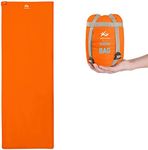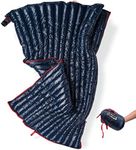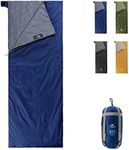Buying Guide for the Best Ultra Compact Sleeping Bag
Choosing an ultra-compact sleeping bag is all about balancing portability, comfort, and warmth. These sleeping bags are designed for people who need to save space and weight, such as backpackers, cyclists, or travelers who want to pack light. When picking the right one, it's important to consider where and when you'll be using it, as well as your own comfort preferences. Understanding the key specifications will help you find a sleeping bag that fits your needs without taking up too much room in your pack.Packed SizePacked size refers to how small the sleeping bag becomes when it's compressed into its storage sack. This is crucial for anyone who needs to save space in their backpack or luggage. Packed sizes can range from very small (about the size of a water bottle) to larger, bulkier options. If you have limited space, look for the smallest packed size that still meets your comfort and warmth needs. However, keep in mind that extremely compact bags may sacrifice some insulation or comfort.
WeightWeight is the total mass of the sleeping bag when packed. This is especially important for backpackers or travelers who carry all their gear. Sleeping bags can range from under a pound to several pounds. Lighter bags are easier to carry but may offer less warmth or durability. Choose a weight that matches your activity: go lighter for long hikes or bike trips, and consider a slightly heavier bag if you prioritize comfort or warmth.
Temperature RatingTemperature rating tells you the lowest temperature at which the sleeping bag will keep you warm. This is a key factor for safety and comfort. Ratings are usually given in degrees Celsius or Fahrenheit. Bags rated for warmer temperatures (above 10°C/50°F) are best for summer or indoor use, while those rated for colder temperatures (down to 0°C/32°F or lower) are suitable for spring, fall, or mild winter conditions. Pick a temperature rating based on the coldest conditions you expect to encounter.
Insulation TypeInsulation type refers to the material inside the sleeping bag that keeps you warm. The two main types are down (natural feathers) and synthetic (man-made fibers). Down is lighter and packs smaller, but can lose warmth if it gets wet. Synthetic insulation is bulkier but keeps you warm even when damp and is usually less expensive. Choose down if you need the lightest, most compact option and can keep it dry; pick synthetic for wet conditions or if you want easier care.
ShapeShape describes the cut of the sleeping bag, which affects both comfort and packability. Mummy-shaped bags are narrow and tapered, making them more compact and efficient at retaining heat, but they can feel restrictive. Rectangular bags offer more room to move but are bulkier. Semi-rectangular or hybrid shapes try to balance space and compactness. If you value space and comfort, go for a roomier shape; if saving space and warmth is your priority, a mummy shape is best.
Shell MaterialShell material is the fabric on the outside of the sleeping bag. It affects durability, water resistance, and how well the bag packs down. Lightweight nylon or polyester shells are common in ultra-compact bags. Some have water-repellent coatings to protect against moisture. If you expect damp conditions, look for a water-resistant shell. For dry environments, focus on lightweight and breathable materials.













